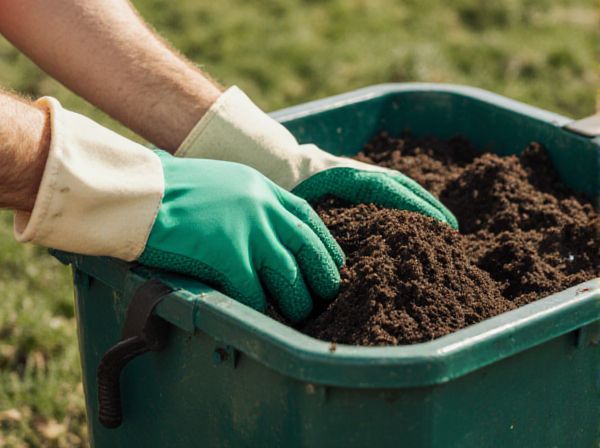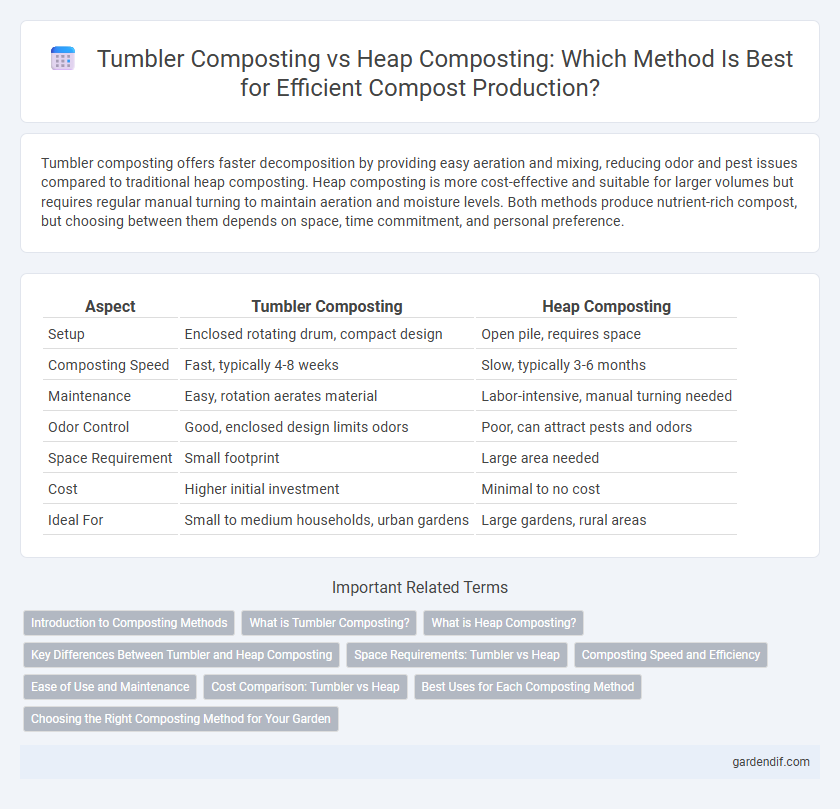
Tumbler composting vs Heap composting Illustration
Tumbler composting offers faster decomposition by providing easy aeration and mixing, reducing odor and pest issues compared to traditional heap composting. Heap composting is more cost-effective and suitable for larger volumes but requires regular manual turning to maintain aeration and moisture levels. Both methods produce nutrient-rich compost, but choosing between them depends on space, time commitment, and personal preference.
Table of Comparison
| Aspect | Tumbler Composting | Heap Composting |
|---|---|---|
| Setup | Enclosed rotating drum, compact design | Open pile, requires space |
| Composting Speed | Fast, typically 4-8 weeks | Slow, typically 3-6 months |
| Maintenance | Easy, rotation aerates material | Labor-intensive, manual turning needed |
| Odor Control | Good, enclosed design limits odors | Poor, can attract pests and odors |
| Space Requirement | Small footprint | Large area needed |
| Cost | Higher initial investment | Minimal to no cost |
| Ideal For | Small to medium households, urban gardens | Large gardens, rural areas |
Introduction to Composting Methods
Tumbler composting involves a sealed container that can be rotated to aerate organic waste, accelerating decomposition and reducing odors while maintaining moisture balance. Heap composting is an open pile method where organic materials decompose naturally through microbial activity, requiring regular turning to ensure proper aeration and temperature control. Both methods recycle kitchen scraps and yard waste into nutrient-rich humus, supporting soil health and sustainable gardening practices.
What is Tumbler Composting?
Tumbler composting involves a sealed, rotatable container designed to speed up organic matter decomposition by providing consistent aeration and moisture control. This method reduces composting time significantly compared to traditional heap composting, often producing finished compost within weeks. Tumbler composts are ideal for small spaces and urban environments due to their compact design and ease of use.
What is Heap Composting?
Heap composting is a traditional composting method involving the collection of organic waste in a simple, open pile or heap where natural decomposition occurs through microbial activity. This method requires minimal equipment and allows airflow and moisture to penetrate the pile, promoting aerobic breakdown of materials like kitchen scraps, garden waste, and leaves. Heap composting is cost-effective and accessible for gardeners, though it typically takes longer to produce finished compost compared to more controlled systems like tumbler composting.
Key Differences Between Tumbler and Heap Composting
Tumbler composting accelerates decomposition by enabling easy turning and aeration within a sealed container, significantly reducing composting time compared to heap composting, which relies on manual turning and natural aeration. Heap composting typically requires more space and can attract pests due to its open structure, whereas tumblers offer a more controlled environment that limits odor and pest issues. Temperature regulation in tumblers is more efficient, promoting faster microbial activity, while heaps may take longer to reach optimal thermophilic phases essential for effective breakdown of organic matter.
Space Requirements: Tumbler vs Heap
Tumbler composting requires significantly less space, making it ideal for small gardens or urban settings, typically occupying a compact footprint of about 3 to 4 cubic feet. Heap composting demands more extensive area, often needing several square feet to form loose piles that promote aeration and microbial activity. Efficient space utilization in tumbler composters accelerates decomposition but limits the volume compared to the expansive but less controlled heap method.
Composting Speed and Efficiency
Tumbler composting accelerates decomposition by providing consistent aeration and easier mixing, resulting in faster composting cycles typically ranging from 4 to 6 weeks. Heap composting relies on natural aeration and manual turning, often extending composting times to several months but accommodating larger volumes of organic waste. Tumbler composters enhance efficiency by maintaining optimal moisture and temperature levels, while heaps may face uneven decomposition due to variable environmental exposure.
Ease of Use and Maintenance
Tumbler composting offers a more user-friendly experience with easy turning mechanisms that speed up decomposition and reduce manual labor. Heap composting requires regular manual turning and monitoring to maintain proper aeration and moisture levels, demanding more time and effort. While tumblers provide a cleaner, more efficient process, heaps offer greater capacity but with increased maintenance challenges.
Cost Comparison: Tumbler vs Heap
Tumbler composting systems typically cost between $80 and $200 due to their durable materials and rotating mechanism, while heap composting incurs minimal expense, relying on natural decomposition in a simple pile. Operating costs for tumblers include occasional maintenance and potential replacement parts, whereas heap composting requires no additional investment beyond initial setup. The higher initial cost of tumblers is often offset by faster composting times and reduced labor compared to heap methods.
Best Uses for Each Composting Method
Tumbler composting is ideal for urban gardeners and small spaces, offering faster decomposition through regular turning and improved aeration, making it perfect for kitchen scraps and quick nutrient recycling. Heap composting suits larger gardens or rural settings where space is abundant, allowing for a variety of organic waste, including yard trimmings and leaves, to decompose naturally over time. Both methods contribute to soil enrichment, but choosing between them depends on compost volume, time available, and the gardener's control preferences.
Choosing the Right Composting Method for Your Garden
Tumbler composting accelerates decomposition by providing optimal aeration and easy turning, making it ideal for smaller gardens and users seeking a faster compost cycle. Heap composting suits larger spaces and those preferring a low-maintenance, natural approach, accommodating a wider range of organic materials over a longer period. Selecting the right composting method depends on garden size, time availability, and desired composting speed.
Tumbler composting vs Heap composting Infographic

 gardendif.com
gardendif.com